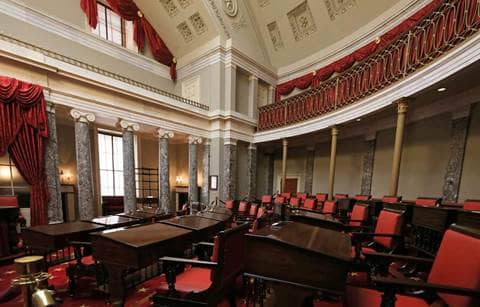In the early morning of May 22, the House passed its version of the One, Big, Beautiful Bill (OBBB) in advance of the Memorial Day holiday. This followed a whirlwind of activity in Congress on the tax portion of the bill that began on May 13 and stretched into the early morning hours of May 22. The result is an amended version of the bill, which would extend the Tax Cuts and Jobs Act (TCJA) and make other significant changes to federal tax law. Attention now shifts to the Senate for consideration of the OBBB, including many likely amendments. Our tax team surveys the OBBB, as passed by the House, and evaluates what such changes would mean for businesses and individuals.
- An eventful trip from Ways and Means Committee to the House floor
- What changed prior to passage in the House?
- Attention shifts to the Senate ahead of the Fourth of July
An eventful trip from Ways and Means Committee to the House floor
House committees marked up their portions of the OBBB in recent weeks to facilitate the compilation of a single bill. The tax portion was considered by the Ways and Means Committee during a marathon session that stretched for 17 hours between May 13 and May 14. Ultimately, that committee approved its portion of the bill by a 26-19 margin, including a net tax decrease estimated to cost $3.8 trillion.
The various portions of the bill were then considered by the House Budget Committee and Rules Committee, respectively. An initial vote to approve the OBBB in the Budget Committee was unsuccessful on May 16. However, such committee reconvened late on May 18 and approved the package. The Rules Committee was next up and began its deliberation at 1:00 a.m. on May 21. Following a long hearing and amendment process, an amended bill was approved by the committee late in the evening that same day.
Negotiations over the substance of the OBBB began during the second half of the week of May 12 and stretched up until passage in the House. Those negotiations escalated, as the bill was considered by the Rules Committee and advanced to the floor for a vote. Reporting and public statements during that negotiating window indicated that the key issue was whether to further restrict spending and the cost of tax changes or expand the tax benefits that would be provided. The SALT cap, Inflation Reduction Act tax credits, and spending programs were important aspects of this debate.
What changed prior to passage in the House?
The tax portions of the OBBB passed by the House are largely identical to those included in the House Ways and Means Committee markup. However, the amended bill does diverge from the earlier draft in meaningful ways. Please see below for a summary of key tax provisions that did change in substantive ways from the House-approved version.
The SALT cap
The Ways and Means bill would’ve increased the $10,000 state and local tax (SALT) deduction limitation to $30,000. The increase above $10,000 would’ve phased out at a rate of 20% of a taxpayer’s modified AGI that exceeded $400,000, with a restoration of the base $10,000 limit at $500,000 of AGI. These increases would have begun in 2026.
The revised version increases the maximum deduction to $40,400 and increases the phaseout rate to 30% of modified AGI that exceeds $505,000. All dollar amounts in the revised version would be increased by 1% each year beginning in 2027 through 2033, at which point the amounts would remain static at the 2033 levels thereafter. The revised bill also provides an increased deduction for the 2025 tax year of $40,000 with a phaseout to the $10,000 limit at 30% of the modified AGI in excess of $500,000. Both versions would halve all amounts with respect to married taxpayers filing separately.
The Ways and Means bill would’ve prevented most businesses from deducting state and local income taxes at the entity level, but the revised version appears to limit this restriction solely to specified service trades or businesses as defined in Section 199A.
Inflation Reduction Act (IRA) tax credits
The Ways and Means version of the bill would’ve made a variety of changes to tax credits created or modified by the IRA. However, many of those changes would’ve been completed on a deferred basis. Such changes would’ve included identical changes to the Investment Tax Credit (ITC) and the Production Tax Credit (PTC), with full phaseout of those credits occurring in 2031. Key changes to IRA credits included how and when the credits would be phased out and how projects involving foreign investment would be treated differently. There were also modifications as to transferability, an aspect of the IRA that allows taxpayers claiming the credit to sell such credits to third parties in exchange for cash payment.
The manager’s amendment maintained this consistency by proposing identical changes to the current, tech-neutral versions of the ITC and PTC.
- The amendment would make both credits unavailable for qualified facilities that either begin construction more than 60 days after the enactment date or are placed in service after 2028. There was some reporting in recent days that nuclear facilities might be separately treated, and under the amended version, the credits for certain nuclear projects wouldn’t be available for facilities that begin construction after 2028.
- The amendment would accelerate the timing of the foreign entity restriction introduced by the Ways and Means version. In the Ways and Means version, facilities that receive material assistance from prohibited foreign entities, a newly defined term, would be ineligible for credits. However, that restriction was set to phase in for projects that begin construction a year or more after the enactment date. The amended version would move up that timing such that facilities with that kind of material assistance would need to begin construction before the end of 2025 to qualify for the credits.
- The amendment would also reverse course on transferability. The unamended version would have terminated the transferability of the credit under Section 6418 as to the PTC and the ITC. The amended version would make no change to transferability as to either, which would allow existing projects to benefit from transferability prior to the expiration of the underlying credits.
- The amendment would also add new sections as to certain investments in otherwise qualifying projects for residential solar for heat, solar for electricity, and wind for electricity. The amendment would deny the credits for these projects where the investments involve rentals (as opposed to direct ownership).
Section 45U, zero-emission nuclear credit
The Ways and Means version would have phased out the zero-emission nuclear production credit at Section 45U by 20% increments. The amended version would eliminate the phaseout, but would advance the sunsetting of the credit. Current law has the credit sunsetting out beginning in 2033. The amended version pushes this up a year, such that it would sunset beginning in 2032.
Other tax changes
- Alternative minimum taxable (AMT) income — While the Ways and Means bill would make permanent the increased AMT exemption and phaseouts enacted by the TCJA, the revised version would slightly decrease those amounts by changing the cumulative inflation factors that have been applied to those amounts since 2019.
- Itemized deduction phaseout — The Ways and Means bill would have effectively capped the benefit of itemized deductions at 35%, even for taxpayers in the 37% bracket. The revised version maintains this phaseout structure but further limits the benefit of the SALT deduction to 32%.
- GILTI and FDII — The Ways and Means bill would have prevented the increase in the effective tax rate on GILTI and FDII income in 2026 that was built in to the TCJA from occurring. The revised version does increase the effective tax rate of such income but at a lower amount than would have otherwise occurred.
- BEAT — The BEAT was originally scheduled to increase from a 10% tax to 12.5% beginning in 2025. The Ways and Means bill would have prevented that increase from occurring. The revised version instead increases the rate to 10.1
- Excise tax on indoor tanning — The Affordable Care Act created an excise tax on indoor tanning services. The Ways and Means bill would have repealed such tax. The revised version leaves such tax in place.
- Transactions between partners and partnerships — The revised version would treat all transactions as if between unrelated persons unless regulations provide otherwise. This provision was inserted into the final House version and represents a bit of a surprise, given the limited discussion of such change in recent weeks.
Attention shifts to the Senate ahead of the Fourth of July
Passage in the House is a significant step that aligns with the Memorial Day deadline previously established by Speaker Johnson. However, the current draft of the OBBB is by no means complete, given recent statements from Republican Senators. As the bill moves to the Senate, it’s expected that at least some changes will be made. The exact nature of such changes will be determined over the coming weeks.
Looming in the distance are three potential deadlines. The earliest, an internal deadline established by Republican leadership, would require passage of the OBBB by Congress ahead of the Fourth of July holiday. The second deadline involves the exhaustion of the debt ceiling, which is the U.S. government’s authorization to borrow funds to cover current expenditures. While a precise date isn’t known, Treasury Secretary Bessent previously asked Congress to extend the debt ceiling by mid-July. Finally, the budget resolution for the OBBB only lasts through the end of the government’s current fiscal year — September 30 — after which a new resolution would be required to authorize the bill. Taken together, those deadlines create an environment for a potential sprint to the finish line in the Senate.





